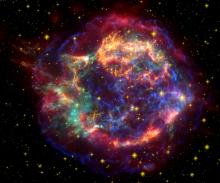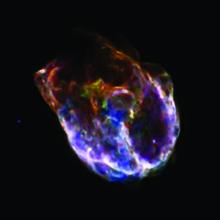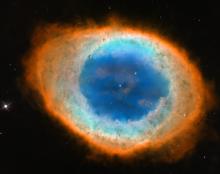Listen to today's episode of StarDate on the web the same day it airs in high-quality streaming audio without any extra ads or announcements. Choose a $8 one-month pass, or listen every day for a year for just $30.
You are here
Making Elements III
Some giant chemical factories arc down the southwestern sky this evening: seven bright stars that outline the constellation Orion. The pattern includes the three stars of Orion’s Belt, which are roughly parallel to the horizon at nightfall, and a four-star rectangle around the belt. Orange Betelgeuse is at the top left corner, with blue-white Rigel at the opposite corner.
All of these stars are supergiants. They’re hundreds of times wider than the Sun, and tens of thousands of times brighter. Most important, they’re many times more massive than the Sun — and that’s what makes them chemical factories.
All stars shine by fusing together elements in their cores to make heavier elements, releasing a lot of energy in the process.
The Sun and similar stars fuse hydrogen to make helium. But supergiants make many other elements as well. Because of their great mass, gravity squeezes them more tightly, making their cores much hotter. That allows them to fuse heavier and heavier elements. In the final stage of life, in fact, such a star is put together like an onion. The core is made of iron, surrounded by layers of silicon, oxygen, neon, carbon, helium, and hydrogen, all mixed with other elements.
It takes too much energy to fuse iron to make heavier elements. So the nuclear reactions come to an end. The core collapses, and the star’s outer layers explode into space — creating even heavier elements as they do. More about that tomorrow.
Script by Damond Benningfield






